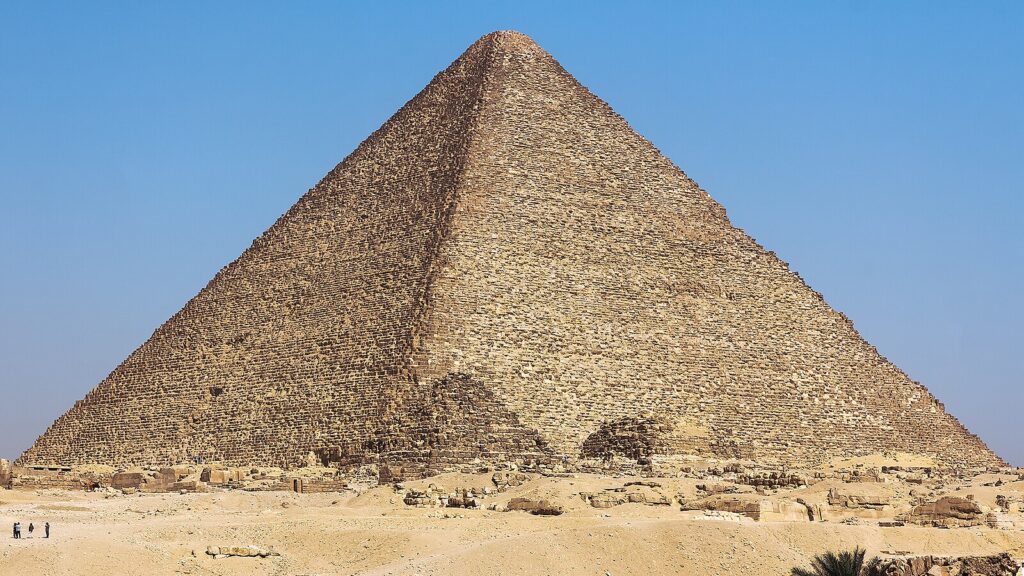Beginnings: 5-6th Grade; Week 4
History
5-6th GRADE: WEEK 4
Unit 2 - Egypt: The Early/Archaic and Old Kingdom
Time Span:
- c. 3100BC – 2040 BC
Key Events:
- Menes unites Upper and Lower Egypt
- Cheops builds the Great Pyramid at Giza
Resources/Materials:
- Blackline Map: Ancient Egypt
Memory Fact:
Tell me about Egyptian history.
Egyptian history in four periods,
It has been divided.
During the Archaic period,
Egypt is united.
In the Old Kingdom, pharaohs are most powerful
And great pyramids are made.
In the Middle Kingdom there’s peace
Until the mighty Hyksos invade.
Lesson at a Glance
Egypt: The Early/Archaic and Old Kingdom
Using the Week 4 slideshow:
- Review: (20 minutes)
- Drill Questions
- Making Connections
- Launch: (35 minutes)
- Present New Content: (10 minutes)
- Activity: (15 minutes)
- Share: (10 minutes)
English Language Arts
5-6th GRADE: WEEK 4

Literature:
- Unit 1: The Golden Goblet
- Week: 4 of 4
- Review: Chapters 11-14
- Focus: Character Development
Grammar:
- Irregular Verbs
- Confusing words: rise/raise, sit/set, lie/lay
Composition:
- IEW: Unit 4
- TWSS: 04 Summarizing a Reference (minute 00:10:45 until 00:47:10)
- Source: Pyramid of Giza (attached)
- Checklist items:
- Dress-ups: all
- Sentence-openers: none
Lesson Plan
Daily Paragraph Editing: ( 10 minutes)
- Using the slideshow, briefly introduce your student(s) to the concepts they will encounter this week. (This is just a quick review, not an indepth lesson. We will discuss these concepts in depth as the year progresses.)
- Have student(s) work indepently to edit Week 4 Monday. In a group setting, use this time to record completion grades on last week’s work.
- Discuss the correct answers. Have the student(s) answer “why” for each correction.
Easy Grammar: ( 10 minutes)
Using the slideshow, teach this week’s grammar concepts:
- Review Verb Phrases
- Review Direct Objects
- Teach Irregular Verbs
- Teach Confusing Words: Rise/Raise; Sit/Set; Lie/Lay
Lesson at a Glance
Understanding Plot Development (45 minutes)
- Discussion: Character Development (10 minutes)
- Activity: Illustrations of key passages on courage and conflict (15 minutes)
- Reflection: Christian Perspective (15 minutes)
- Homework Explanation: (5 minutes)
Lesson at a Glance
Summarizing a Source: Cheops / The Great Pyramid at Giza (45 minutes)
- Introduction: Read the article, discuss, and brainstorm (5-10 minutes)
- Outlining: (10-20 minutes)
- Stylistic Elements: Teach / Review stylistic elements taught to date (10-15 minutes)
- Sharing and Discussion: (5 minutes)
- Homework Explanation: Students should use the outline created to write a one-paragraph summary of the source and finalize using the Week 4 Checklist. (5 minutes)
Oral Communications
5-6th GRADE: WEEK 4

5-6th Grade:
Unit 2: Introductory Speech
- Students will give an introductory speech next week.
- In preparation, this week they will practice presenting improv style:
- First, they will present about themselves following a formula, and giving as much information as possible in one minute.
- Second, they will draw a character card and introduce themselves as that character.
Lesson at a Glance:
Introduction Improv: “Me in a Minute” and “Character Spotlight” (30-55 minutes)
- “Me in a Minute:” Students practice introducing themselves giving as much inforamtion as possible following a formula in one minute (10-25 minutes)
- “Character Spotlight:” Students draw a character card and step into the “spotlight,” introducing themselves as the character they drew.
- Homework Explanation: Students should follow the directions in the curriculum guide to develop an introductory speech they will present next week. (5 minutes)
Science
5-6th GRADE: WEEK 4
Unit 2 - Superstructure: Cells and DNA
Resources/Materials: Paper plates and food items for edible plant cell model
Tell me about Plant and Animal Cells
Plant and Animal Cells have parts
That are the same.
The cell membrane is the skin.
The nucleus is the brain.
The cytoplasm is a network
For transportation.
The mitochondria is
The mighty power station.
The vacuoules are warehouses
That store food.
Plant cells have two extra parts
That we can’t exclude.
A chloroplast for photosynthesis.
And an outer cell wall
That makes the plant rigid
So it can grow tall.
Tell me about DNA
DNA is a ladder-like molecule
That is twisted and compressed.
A double helix is the name
That fits it best.
It stores genetic code:
The instructions in a gene
That work together to make
A complex human being.
Lesson at a Glance
Super Structure: Cells and DNA
Using the Week 4 slideshow:
- Review: (10 minutes)
- Drill Questions
- Making Connections
- Launch: (20 minutes)
- Introduce New Content
Activity: (See Detailed Directions)
- Color and label diagram of plant cell (20 minutes)
- Build an edible plant cell
Bible/Latin
5-6th GRADE: WEEK 4
Bible
Chapter 4 Bible History:
- Cain and Abel
- Noah and the Flood
- The Tower of Babel
Memory Verse:
- Genesis 11:9 (ESV)
- Seeds Family Worship:
- Album: I am with You
- Song: “Babel”
Latin
Week 4:
- Noun Cases
- First Declension Noun Endings

The Tower of Babel
Lesson at a Glance
Bible: (25 minutes)
- Review (10 minutes)
- Bible History (10 minutes)
- Scripture Memory (5 minutes)
- Closing Prayer
Latin: (30 minutes)
- Lesson Launch and Review using Week 4 Slideshow (20 minutes)
- Review Activity: Word Charades (10 minutes)



